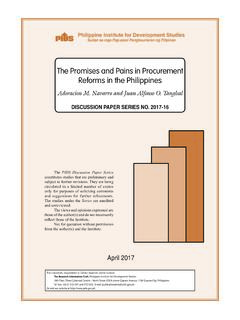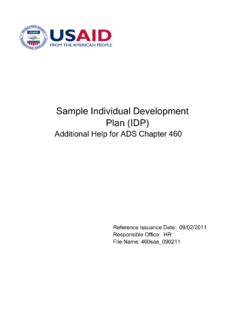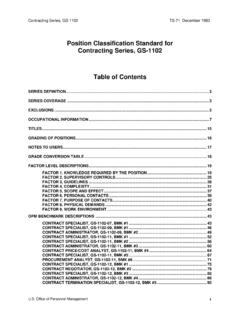Transcription of Defense Primer: Planning, Programming, Budgeting and ...
1 Updated December 11, 2020 Defense primer : planning , programming , Budgeting and Execution (PPBE) ProcessIntroduction planning , programming , Budgeting , and Execution (PPBE) is the Department of Defense (DOD) process for allocating resources. The annual process serves as the framework for DOD civilian and military leaders to decide which programs and force structure requirements to fund based on strategic objectives. This product describes the notional process from the perspective of the Office of the Secretary of Defense . In practice, aspects of the process can change based on current events or leadership preferences.
2 DOD policy states that PPBE serves as the annual resource allocation process for the department over a multi-year planning cycle. According to DOD policy, the objective of the process is to provide the DOD with the most effective mix of forces, equipment, manpower, and support attainable within fiscal constraints. Chairman of the Joint Chiefs of Staff Instruction describes the process as the Secretary of Defense s institutional strategic planning system and the primary decision-making process for translating strategic guidance into resource allocation decisions. The process is designed to produce DOD s portion of the President s annual budget request to Congress and updates to the department s five-year spending plan known as the Future Years Defense Program, or FYDP (sometimes pronounced fiddip ).
3 The process is also one leg of a triad of acquisition-related decision support systems that includes the Joint Capabilities Integration and Development System (JCIDS) for developing requirements to address capability gaps and the Defense Acquisition System (DAS) for managing acquisition programs. Background In 1961, then-Secretary of Defense (SECDEF) Robert S. McNamara created the planning , programming , and Budgeting System (PPBS) to establish a framework for connecting strategic objectives with resources. In 2003, DOD renamed the system PPBE in part to emphasize the need to better manage the execution of budget authority provided by Congress.
4 The Deputy Secretary of Defense assists the SECDEF in the overall PPBE leadership role by managing the process on a day-to-day basis. PPBE is a calendar-driven process that, for any fiscal year cycle, typically begins more than two years before the expected year of budget execution. PPBE is part of DOD s Resource Allocation Process, a timeline intended to show when actions associated with a particular fiscal year cycle are supposed to occur during a calendar year (see Figure 1). DOD makes a distinction between the execution phase of PPBE, also known as execution review, and the execution of congressional appropriations in the Resource Allocation Process figure.
5 (For more information, see the Execution section below.) PPBE Phases The first three phases typically produce a specific product unique to that phase and year. The planning phase produces the Defense planning Guidance (DPG), which details force development priorities. The programming phase generates a Program Objective Memorandum (POM), a funding plan for each military service and Defense agency covering a five-year period that adjusts programs in the FYDP. The Budgeting phase results in a Budget Estimate Submission (BES), which covers the first year of the POM and converts programs into budget terms for submission to Congress.
6 Figure 1. DOD Resource Allocation Process (notional) (fiscal year cycle by calendar year and month) Source: CRS graphic based on DOD references. Notes: CY is calendar year; FY is fiscal year. Execution as shown is based on appropriations available for one year. planning The Under Secretary of Defense for Policy leads the planning phase. The Chairman of the Joint Chiefs of Staff (CJCS) also plays a significant role in the process, in accordance with responsibilities as the principal military advisor to the SECDEF under 10 151. The CJCS s role is, in part, to advocate for solutions to department-wide requirements.
7 The phase involves reviewing the President s National Security Strategy (NSS), the SECDEF s National Defense Strategy (NDS), and the CJCS s National Military Strategy (NMS) to ensure the resulting Defense planning Guidance (DPG) aligns with the Administration s policy goals and takes into account potential threats, force structure, readiness posture, and other factors. The DPG, developed with input from the CJCS, military services, and combatant commanders, typically contains guidance on investments and divestments for the services and helps inform their Program Objective Memorandum (POM). Defense primer : planning , programming , Budgeting and Execution (PPBE) Process programming The programming phase is meant to analyze the anticipated effects of present-day decisions on the future force.
8 The Director of the Cost Assessment and Program Evaluation (CAPE) Office leads this phase. The programming phase begins with the heads of each military service and Defense agency developing a Program Objective Memorandum (POM), which describes proposed resource requirements (forces, manpower, and funding) for programs over five years. The POM prioritizes and adjusts programs in the FYDP. The POM can also describe the risks associated with underfunded or unfunded programs. Once each service submits a POM, CAPE leads the reviews of the programs, forecasts the resource requirements for the next five years, and updates the FYDP.
9 As a result of this program review, the SECDEF can direct the services to make changes. Budgeting The Under Secretary of Defense (Comptroller)/Chief Financial Officer leads the Budgeting phase, in which the military services complete a Budget Estimate Submission (BES) for the first year of the FYDP. Under guidance from the Office of Management and Budget (OMB), the Comptroller reviews the budget submissions to ensure appropriate funding and fiscal controls, phasing of the efforts over the funding period, and feasibility of execution within the budget year. During this phase, Comptroller analysts work with service counterparts to review budget requests and ensure they align with the unified Defense budget.
10 As a result of this budget review, the SECDEF can direct the services to make changes. The final product is intended for submission to OMB each December for inclusion in the President s annual budget request to Congress, which is usually submitted in February. Execution The final phase, execution, also known as execution review, is intended to evaluate program results. The execution review occurs at the same time as the program review (to prioritize the programs that best meet strategic goals) and the budget review (to decide how much to spend on each program). Thus, execution review is intended to assess a program s actual performance compared to its planned performance.
















